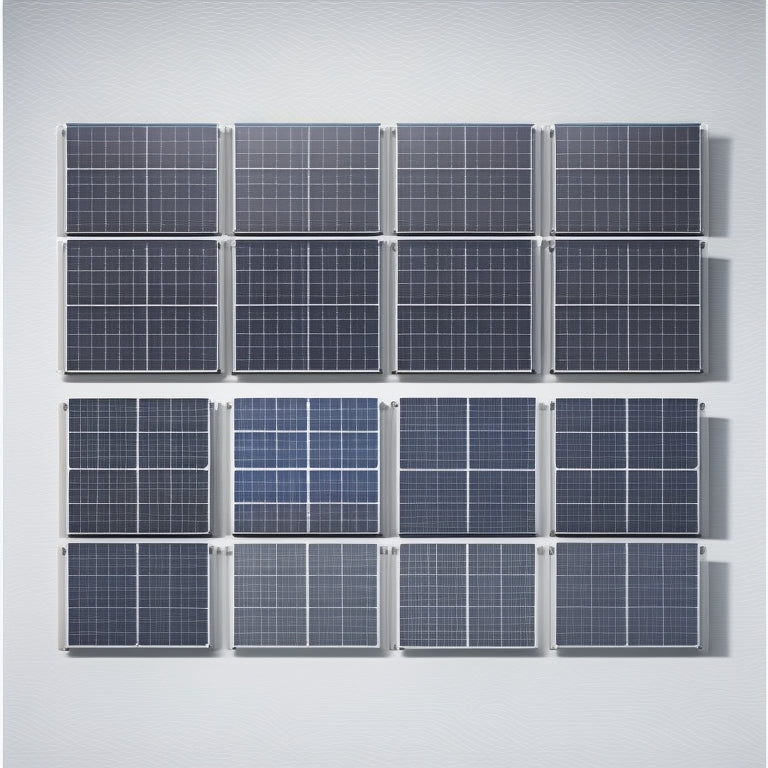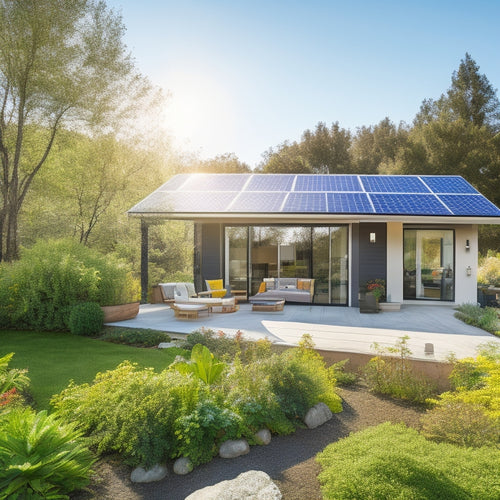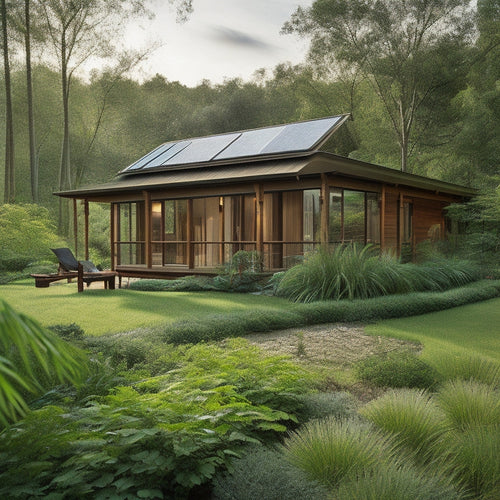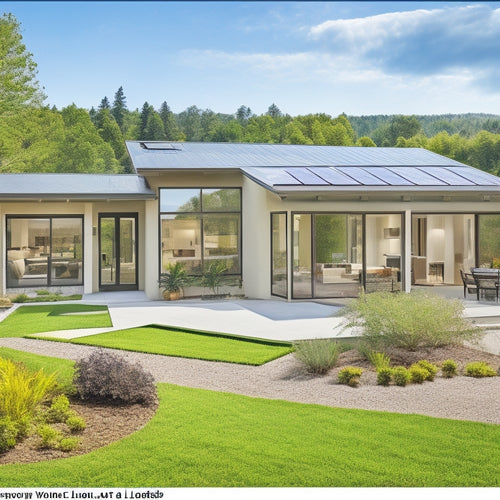
Top 10 Sizes of Residential Solar Panels Available Today
Share
You have a wide range of residential solar panel sizes to choose from, spanning from compact 250-Watt options to large 500-Watt systems, each designed to cater to specific energy needs, roof spaces, and budgets. Mid-range options like 320-Watt panels offer a balance between power output and cost, while premium 480-Watt models maximize energy production with minimal roof space. Other popular sizes include 300-Watt, 360-Watt, 400-Watt, 420-Watt, and 450-Watt options, each with their unique benefits. Understanding the features and benefits of each size will help you make an informed decision, and exploring these options further will reveal the perfect fit for your solar energy needs.
Key Takeaways
- Residential solar panels range from 250-Watt to 500-Watt options, catering to varying energy demands and roof spaces.
- High-efficiency panels (300-Watt and above) offer impressive energy conversion rates, ideal for larger homes or high energy demands.
- Mid-range options (320-Watt) balance power output and cost considerations, making them suitable for most residential installations.
- Larger panels (400-Watt and above) maximize energy production per unit area, reducing the number of panels needed and installation costs.
- Compact options (250-Watt and 280-Watt) are designed for smaller homes, apartments, or condos, offering lower upfront costs and flexibility.
300-Watt Residential Solar Panels
Your residential solar panel installation likely includes 300-Watt panels, a popular choice among homeowners. These high-efficiency panels offer a higher wattage rating, making them ideal for larger homes or those with high energy demands. You'll benefit from increased power output and a more efficient use of roof space.
When it comes to watt efficiency, 300-Watt panels boast an impressive rate of around 20%. This means they can convert 20% of the sun's energy into usable electricity. In comparison, lower-wattage panels typically have an efficiency rate of around 15-18%. The increased efficiency of 300-Watt panels results in more power per hour of sunlight.
There are various solar panel types that fall within the 300-Watt category. Monocrystalline silicon panels, for instance, are known for their high efficiency and durability.
Polycrystalline silicon panels, on the other hand, offer a more affordable option without sacrificing too much efficiency. Regardless of the type, 300-Watt panels provide a reliable and efficient source of renewable energy for your home.
Smaller 250-Watt Solar Options
Many homeowners opt for smaller 250-Watt solar options when their energy needs are lower or roof space is limited. You'll find these panels ideal for smaller homes, apartments, or condos where energy requirements are modest.
When considering a 250-Watt installation, think about the space requirements and system compatibility. You'll need to verify the panels fit your roof and integrate seamlessly with your existing electrical infrastructure.
Cost effectiveness is another key benefit of 250-Watt panels. With lower upfront costs, you can enjoy a faster return on investment. Additionally, many governments offer energy rebates for solar installations, which can further offset your expenses.
When selecting an inverter, choose one that's compatible with your panel's voltage and current output. Regular maintenance tips include cleaning the panels seasonally and monitoring performance to guarantee peak energy production.
In terms of environmental impact, 250-Watt solar panels can considerably reduce your carbon footprint. By connecting to the grid, you can feed excess energy back into the system and offset your consumption.
With proper installation considerations and inverter selection, you can enjoy a reliable and efficient solar energy system that meets your unique needs.
Mid-Range 320-Watt Panels
As energy demands increase, homeowners often require more resilient solar solutions, which is where mid-range 320-Watt panels come into play. You'll find these panels offer a sweet spot between power output and cost considerations. With their increased wattage, you can generate more energy while still being mindful of your budget.
When considering mid-range 320-Watt panels, keep the following options in mind:
| Manufacturer | Model | Efficiency |
|---|---|---|
| Panasonic | VBHN320SA17 | 20.6% |
| Trina Solar | TSM-320DD05A | 19.9% |
| Jinko Solar | CSH3-320P | 19.4% |
| LONGi Solar | LR6-60PE-320M | 20.3% |
| Hanwha Q CELLS | Q.PEAK DUO BLK-G6-320 | 20.1% |
When installing mid-range 320-Watt panels, remember to follow these installation tips: guarantee proper alignment to maximize energy output, consider using a tracking system to optimize energy generation, and always follow the manufacturer's installation guidelines. By doing so, you'll be able to utilize the full potential of your mid-range 320-Watt panels and enjoy a significant reduction in your energy bills.
Larger 400-Watt Solar Panels
Take a step up to the next level of energy generation with larger 400-Watt solar panels, designed to meet the increasing demands of modern homes.
These high-performance panels are ideal for homeowners who want to maximize their energy production and reduce their carbon footprint.
When considering a 400-Watt solar panel installation, keep in mind the following key factors:
-
Increased energy output: With more power per panel, you'll need fewer panels to achieve your desired energy output, resulting in a more efficient installation.
-
Optimized roof space: By generating more power per panel, you can make the most of your available roof space, reducing the overall number of panels needed.
-
Improved cost benefits: With higher energy output comes greater savings on your electricity bills, making the investment in 400-Watt solar panels more cost-effective in the long run.
When it comes to installation considerations, be certain to assess your roof's structural integrity and verify it can support the added weight and size of these larger panels.
Additionally, consider consulting with a professional installer to determine the best configuration for your specific energy needs.
High-Efficiency 420-Watt Models
You're looking for high-efficiency 420-watt solar panels that can maximize your energy harvest.
It's crucial to understand that power density matters, as it directly impacts the amount of energy you can generate per unit area.
With these compact designs, you can achieve maximum energy production while minimizing the required rooftop space.
Power Density Matters
High-efficiency solar panels boasting 420 watts of power have revolutionized the residential solar industry, offering unparalleled power density.
You're now able to generate more energy from a smaller surface area, making them ideal for homes with limited roof space.
When considering these high-efficiency models, power density matters. Here's why:
-
Increased energy production: With higher power density, you can generate more energy from the same surface area, reducing the overall number of panels needed.
-
Improved installation flexibility: Higher power density panels provide more flexibility during installation, allowing for more efficient use of available roof space.
-
Reduced installation costs: Fewer panels mean less material, labor, and complexity, resulting in lower installation costs.
As you investigate these high-efficiency options, keep in mind the installation considerations that come with them.
You'll need to verify your roof can support the added weight and that your electrical infrastructure can handle the increased power output.
Maximum Energy Harvest
Your roof's energy harvesting potential is greatly enhanced with the adoption of 420-watt solar panels, which boast an impressive maximum power point tracking (MPPT) range.
These high-efficiency models optimize energy output by tracking the maximum power point of the solar panel array, guaranteeing you get the most out of your solar investment. With an increased solar panel efficiency of up to 22%, you can generate more power per unit area, reducing the overall number of panels required for your installation.
When considering the installation of 420-watt solar panels, you'll need to factor in the increased power output and its impact on your electrical infrastructure. It's crucial to verify your inverter and electrical panel can handle the increased energy production.
Additionally, installation considerations such as panel orientation, tilt, and shading will greatly affect the overall performance of your solar array. By carefully planning your installation and choosing the right components, you can access the full potential of these high-efficiency solar panels and maximize your energy harvest.
Compact Design Benefits
With their increased power density, 420-watt solar panels offer a more compact design that can greatly benefit your residential solar installation.
By packing more power into a smaller area, these high-efficiency models enable you to generate more energy while using less space.
This compact design provides several advantages, including:
-
Space optimization: With more power per panel, you can fit more energy-generating capacity into a smaller area, making them ideal for homes with limited roof space.
-
Installation flexibility: The compact design of 420-watt solar panels gives you more flexibility when it comes to installation. You can fit them in tight spaces, around vents, or in areas with obstructions.
-
Easier maintenance: With fewer panels required to achieve the same energy output, you'll have fewer connections to maintain and inspect, reducing the overall maintenance burden.
Residential 450-Watt Solar Solutions
One of the most popular residential solar solutions on the market today is the 450-watt solar panel, which offers a perfect balance between efficiency and affordability.
You'll appreciate the benefits of this size, including a higher power output per panel, resulting in fewer panels needed to achieve your desired system size. This means you'll require less roof space and fewer installation hours, ultimately reducing your upfront costs.
When considering a 450-watt solar panel installation, you'll want to assess your roof's size, orientation, and shading conditions to determine the best system design.
Confirm your roof can structurally support the weight of the panels, and consider hiring a professional installer to guarantee a safe and efficient installation.
With the right installation, you can reap the benefits of this high-powered solar solution, including increased energy production and a faster return on investment.
Compact 280-Watt Solar Designs
Smaller rooftops or those with partial shading can still capture the power of the sun with compact 280-watt solar designs.
These systems are perfect for homes with limited roof space or unique building characteristics that require a more customized approach.
You'll appreciate the installation benefits of compact 280-watt solar designs, which include:
-
Increased energy density: More power per square foot means you can generate the energy you need without sacrificing precious roof space.
-
Improved aesthetics: Compact designs often feature sleek, modern panels that blend seamlessly into your roof's structure.
-
Enhanced flexibility: With more options for panel placement and configuration, you can adapt your system to your home's unique needs and constraints.
Premium 480-Watt Solar Panels
Your home's energy demands are met with the superior performance of premium 480-watt solar panels, engineered to maximize energy production while minimizing roof space requirements.
These high-power panels deliver exceptional efficiency, converting sunlight into electricity at an impressive rate. With a higher wattage, you'll need fewer panels to meet your energy needs, resulting in a more streamlined installation. This, in turn, reduces installation costs and labor time.
When considering premium 480-watt solar panels, keep in mind that they may require specialized inverters and mounting systems to accommodate their higher power output. However, the cost benefits of these panels far outweigh the additional installation considerations.
You'll enjoy lower costs per watt, increased energy production, and a faster return on investment. By choosing premium 480-watt solar panels, you're investing in a high-performance system that will power your home efficiently and effectively for years to come.
Energy-Efficient 360-Watt Options
You're looking for energy-efficient solar panels that can maximize your energy harvesting.
With 360-watt options, you can achieve high power density, which means more energy is generated per unit area.
These efficient panels can optimize your solar array's performance, making the most of available roof space.
High Power Density
Within the domain of residential solar panels, high power density options have emerged as a breakthrough, particularly with the advent of energy-efficient 360-watt modules.
As you examine the market, you'll notice that these high-power modules offer exceptional solar panel efficiency, resulting in significant residential energy savings.
High power density means you can generate more electricity per unit area, making the most of your rooftop real estate.
Here are three key benefits of high power density solar panels:
-
Increased energy output: With higher power density, you can generate more electricity from the same surface area, reducing the number of panels needed to meet your energy requirements.
-
Improved space utilization: By packing more power into each panel, you can accommodate more panels on your roof, maximizing your energy harvest.
-
Enhanced system reliability: Fewer panels mean fewer connections and junctions, reducing the likelihood of faults and failures, and ensuring a more reliable system overall.
Efficient Energy Harvesting
As homeowners increasingly prioritize renewable energy, efficient energy collection has become an essential aspect of residential solar panel systems. You're likely looking for ways to maximize your energy output while minimizing your carbon footprint. That's where energy-efficient 360-watt options come in. These high-performance panels boast advanced energy collection techniques, ensuring you get the most out of every sunbeam.
When it comes to solar panel efficiency, every percentage point counts. Look for panels with high-efficiency ratings, typically above 20%. These panels are designed to convert a higher percentage of sunlight into usable electricity, resulting in more power per hour of sunlight.
Additionally, consider panels with bifacial technology, which can gather energy from both the front and back sides of the panel. This innovative design can increase energy output by up to 25%. By investing in energy-efficient 360-watt solar panels, you'll be generating more power while reducing your environmental impact.
Large 500-Watt Residential Systems
Installing large 500-watt residential systems marks a significant milestone in utilizing solar energy for your home.
With the increasing demand for renewable energy, these systems have become a popular choice for homeowners seeking to reduce their carbon footprint.
When considering the installation of a 500-watt system, you'll need to take into account several key factors:
-
Installation considerations: Confirm your roof is structurally sound and has sufficient space to accommodate the larger panels.
-
Cost analysis: While the upfront cost of a 500-watt system may be higher, the long-term savings on your energy bills will be more substantial.
-
Energy output optimization: Properly orienting and angling the panels will maximize energy production and reduce energy losses.
Frequently Asked Questions
What Is the Average Lifespan of Residential Solar Panels?
You're likely to get 25-30 years of reliable energy output from your residential solar panels, thanks to durable solar panel materials that guarantee consistent energy efficiency, even in harsh weather conditions.
Do Solar Panels Work During Power Outages?
You're wondering if solar panels work during power outages - a common myth to debunk. In reality, they don't, unless you have energy storage. Investigating this theory reveals that grid-tied systems prioritize safety, shutting down during outages to prevent backfeeding, but with energy storage, you can maintain peak solar panel performance.
Can I Install Solar Panels on a Metal Roof?
You can install solar panels on a metal roof, leveraging its advantages like durability and water-tightness; however, you'll need to take into account installation specifics, such as specialized clamps and waterproofing, to guarantee a secure and efficient setup.
How Often Should I Clean My Solar Panels?
You should clean your solar panels every 6-12 months, depending on local debris and pollution levels, to maintain ideal energy output; regular solar panel maintenance guarantees maximum efficiency, and cleaning frequency is vital to minimize energy losses.
Are Solar Panels Covered by Homeowners' Insurance?
You'll be relieved to know that solar panels are typically covered by your homeowners' insurance, which often includes insurance coverage for damage, theft, and other risks, in addition to the manufacturer's solar panel warranties that usually last 25 years or more.
Conclusion
As you explore the residential solar panel market, you're now equipped with an all-encompassing guide to the top 10 sizes available today. Imagine a canvas of sleek, high-efficiency panels unfolding across your rooftop, utilizing the sun's energy to power your home. From compact 280-Watt designs to large 500-Watt systems, the perfect fit awaits. With this knowledge, you're one step closer to changing your energy environment and illuminating a sustainable future.
Related Posts
-

Green Home Improvements Using Solar Power
Investing in solar power alters your home into a sustainable haven while slashing energy costs. You can greatly reduc...
-

Affordable Sustainable Building Materials for Homes
You can build an eco-friendly home on a budget by choosing affordable sustainable materials. Consider using reclaimed...
-

Passive Solar Design Strategies for Homes
To effectively implement passive solar design strategies in your home, focus on ideal building orientation and strate...


